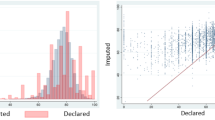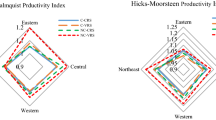Abstract
We propose a new methodology to estimate empirically the input price-induced technical change and total factor productivity (TFP) growth in China. Our primary goal is to test Hicks’ induced innovation hypothesis by examining whether technical change in China has been induced by sharp increase in input prices that have accompanied its rapid economic growth. Utilizing the idea of a firm’s two-stage optimization problem, we develop a new parametric form of the variable profit function wherein the derived input demand and output supply functions can be easily constrained to be regular, and the functional structure is parsimonious in the number of parameters. Applying this methodology to Chinese time series data for 1986–2017, we find that not only is wage-induced innovation significant and quantitatively important, but also that it substantially buffered a decline in TFP growth before 2006 that would otherwise be substantial. Overall, we conclude that China’s economic growth is predominantly driven by wage-induced innovation along with massive injection of heavily subsidized physical inputs in public works and huge investment in industrial sectors.

Similar content being viewed by others
Notes
As a matter of fact, computable general equilibrium models typically do not use flexible functional forms.
By “effectively global regularity,” it is meant that the regularity properties are satisfied in an unbounded region in input-output space, potentially including all points in the sample and all points corresponding to a higher level of output price. A good example of such model is Cooper, McLaren and Wong’s (2001) Modified Gorman Polar Form.
To be consistent with the second stage problem Eq. (6), we admit that \(\left( {p_t,\,{{{\mathbf{w}}}}_{{{\mathrm{t}}}},\,{{{\mathbf{z}}}}_{{{\mathrm{t}}}},\,\overline v _{t - 1}} \right)\) should be the conditioning variables of the optimizer V*. Note however that \(\overline v _{t - 1}\) is not directly measurable whilst preliminary results indicate the incorporation of \(\left( {p_t,\,{{{\mathbf{w}}}}_{{{\mathrm{t}}}},\,{{{\mathbf{z}}}}_{{{\mathrm{t}}}}} \right)\) in V* is not statistically significant (based on the Wald test results). Therefore, we make the theoretical model more empirically operational by simplifying Eq. (7) as \({{{\mathrm{V}}}}^ \ast \left( {\widetilde {{{\mathbf{w}}}}_{{{{\mathrm{t - 1}}}}}{{{\mathrm{, }}}}t} \right)\).
We have conducted the Chi-square based Wald tests to examine different forms of structural change (for example, including the trend variables t and t2, lagged input prices \({{{\tilde{\mathbf w}}}}_{{{{\mathrm{t - 1}}}}}^{}\) or the intercept terms of the supply/demand system). Results (available from the authors upon request) indicated that the form of structural change illustrated in Eq. (13) gave sensible parameter estimates and was supported by the data.
See Ray and Segerson (1990, p.44).
See Chambers (1988, p.132).
Following Kohli (1978 and 1993), we treat imports as an intermediate input of production, which is appropriate in the case of China. As indicated by Xu and Mao (2018), the share of imports that consist of intermediate inputs has increased from 67.6 to 78.6 % during 1995-2013. In addition, retail and domestic handling are still needed for most finished imported goods.
Data on coal and oil consumption are net of that used for non-production purposes.
We have estimated various models based on different specifications of three-period moving averages such as \(\widetilde {{{\mathbf{w}}}}_{{{{\mathrm{t - 1}}}}}\) = (\(\widetilde {{{\mathbf{w}}}}_{{{{\mathrm{t - 1 - }}}}\tau }\) + \(\widetilde {{{\mathbf{w}}}}_{{{{\mathrm{t - 2 - }}}}\tau }\) + \(\widetilde {{{\mathbf{w}}}}_{{{{\mathrm{t - 3 - }}}}\tau }\))/3 for τ ≥ 0. Based on the Bayesian information criterion, the preferred value of τ is zero, implying that Eq. (24) may be the preferred specification of long run lagged input prices.
The superscript “n” indicates the last row (row and column) of the respective vector (matrix) has been annihilated.
See Kohli (1993, p. 248).
In notation, \({{{\mathrm{WIIE}}}}_{{{\mathrm{t}}}} = {{{\mathrm{E}}}}_{{{{\mathrm{{\Pi}}}}}^ \ast \widetilde {{{\mathrm{w}}}}_{{{{\mathrm{1t - 1}}}}}} \dot {\widetilde w}_{1t - 1} \cdot {\textstyle{{{\Pi}^ \ast } \over {p_t{{{\mathrm{Y}}}}_{{{\mathrm{t}}}}^ \ast }}}\) which measures the rate of technical change induced by an increase in the lagged long run wage rate \(\widetilde w_{1t - 1}\).
See Hsieh and Klenow (2009, p. 1405).
See Wei et. al (2017, p. 50).
References
Abramovitz M (1956) Resource and Output Trends in the United States Since 1870. Am Econ Rev 46(2):5–23
Barnett WA (2002) Tastes and Technology: Curvature is Not Sufficient for Regularity. J Econ 108(1):199–202
Cao KH, Birchenall JA (2013) Agricultural Productivity, Structural Change, and Economic Growth in Post-Reform China. J Dev Econ 104:165–180
Celikkol P, Stefanou S (1999) Measuring the Impact of Price-Induced Innovation on Technological Progress: Application to the U.S. Food Processing and Distribution Sector. J Product Anal 12(2):135–151
CEIC (2020) China Premium Database. https://insights.ceicdata.com/. Accessed 10 Dec 2020
Chambers RG (1988) Applied Production Analysis: A Dual Approach. Cambridge University Press, Cambridge
Chen C, Lan Q, Gao M, Sun Y (2018) Green Total Factor Productivity Growth and Its Determinants in China’s Industrial Economy. Sustainability 10(4):1–25
Chen S, Jefferson GH, Zhang J (2011) Structural Change, Productivity Growth and Industrial Transformation in China. China Econ Rev 22(1):133–150
China Prices Press (1998) Prices in China for 50 Years (1949–1998). China Prices Press (in Chinese), Beijing
Cooper RJ, McLaren KR (1996) A System of Demand Equations Satisfying Effectively Global Regularity Conditions. Rev Econ Stat 78(2):359–364
Cooper RJ, McLaren KR, Wong KKG (2001) On the Empirical Exploitation of Consumers’ Profit Functions in Static Analyses. Econ Lett 72(2):181–187
Cooper RJ, McLaren KR, Rehman F, Szewczyk WA (2015) Economic Welfare Evaluation in an Era of Rapid Technological Change. Econ Lett 131:38–40
Daqing Municipal Bureau of Statistics (2016) Daqing Statistical Yearbook 2016. China Statistics Press (in Chinese), Beijing
Diewert WE, Wales TJ (1987) Flexible Functional Forms and Global Curvature Conditions. Econometrica 55(1):43–68
Esposti R, Pierani P (2008) Price-Induced Technical Progress in Italian Agriculture. Rev Agric Environ Stud 89(4):5–28
Feenstra RC, Inklaar R, Timmer MP (2015) The Next Generation of the Penn World Table. Am Econ Rev 105(10):3150–3182
General Administration of Customs of China (1993) China’s External Trade Indices Monthly 1983–1992. China Customs Press (in Chinese), Beijing
General Administration of Customs of China (2008) China’s External Trade Indices 1993–2004. China Customs Press (in Chinese), Beijing
Gil JM, Dhehibi B, Kaabia MB, Angulo AM (2004) Non-stationarity and the Import Demand for Virgin Olive Oil in the European Union. Appl Econ 36(16):1859–1869
Hicks JR (1932) The Theory of Wages. Macmillan, London
Holz C (2019) PRC Industrial Policies Postdate Rather Than Lead Economic Activity. CESifo Working Paper No. 8097. https://www.econstor.eu/bitstream/10419/215099/1/cesifo1_wp8097.pdf. Accessed 15 June 2021
Hong E, Sun L (2011) Foreign Direct Investment and Total Factor Productivity in China: A Spatial Dynamic Panel Analysis. Oxf Bull Econ Stat 73(6):771–91
Hsieh C-T, Klenow PJ (2009) Misallocation and Manufacturing TFP in China and India. Quarterly J Econ 124(4):1403–48
Karagiannis G, Mergos G (2000) Total Factor Productivity Growth and Technical Change in a Profit Function Framework. J Product Anal 14(1):31–51
Kohli RU (1978) A Gross National Product Function and the Derived Demand for Imports and Supply of Exports. Canadian J Econ 11(2):167–182
Kohli RU (1993) A Symmetric Normalized Quadratic GNP Function and the U.S. Demand for Imports and Supply of Exports. Int Econ Rev 34(1):243–255
Kumbhakar S (2002) Productivity Measurement: A Profit Function Approach. Appl Econ Lett 9(5):331–334
Lopez R (1984) Estimating Substitution and Expansion Effects Using a Profit Function Framework. Am J Agric Econ 66(3):358–367
McLaren KR, Yang O (2016) A Class of Demand Systems Satisfying Global Regularity and Having Complete Rank Flexibility. Empir Econ 51:315–337
Mankiw NG, Romer D, Weil DN (1992) A Contribution to the Empirics of Economic Growth. Quarterly J Econ 107(2):407–437
Moschini G, Meilke KD (1989) Modeling the Pattern of Structural Change in U.S. Meat Demand. Am J Agric Econ 71(2):253–261
Moschini G, Moro D (1994) Autocorrelation Specification in Singular Equation Systems. Econ Lett 46(4):303–309
National Bureau of Statistics of China (1997) The Gross Domestic Product of China, 1952–1995. Northeast University of Finance and Economics Press, Liaoning
National Bureau of Statistics of China (2010) China Compendium of Statistics 1949–2008. China Statistics Press (in Chinese), Beijing
National Bureau of Statistics of China (2019). National Data. http://data.stats.gov.cn/easyquery.htm?cn=C01. Accessed 17 Jan 2019
National Bureau of Statistics of China (2020) 2020 China Price Statistical Yearbook. China Statistics Press (in Chinese), Beijing
Ng S (1995) Testing for Homogeneity in Demand Systems when the Regressors are Nonstationary. J Appl Econ 10:143–163
Nordhaus W (2002) Modeling Induced Innovation in Climate Change Policy. In: Grubler A, Nakicenovic N, Nordhaus W (Eds.) Technological Change and the Environment. Resources for the Future Press, Washington, DC, p 182–209
Ohtani K, Katayama S-ichi (1986) A Gradual Switching Regression Model with Autocorrelated Errors. Econ Lett 21(1986):169–72
Peeters L, Surry Y (2000) Incorporating Price-Induced Innovation in a Symmetric Generalised McFadden Cost Function with Several Outputs. J Product Anal 14(1):53–70
Qinhuangdao Coal Network (2020). The Bohai-Rim Steam-Coal Price Index. http://www.cqcoal.com/exp/exponent.jsp. Accessed 10 Dec 2020
Ray SC, Segerson K (1990) A Profit Function Approach to Measuring Productivity Growth: The Case of U.S. Manufacturing. J Product Anal 2(1):39–52
Shumway CR, Cowan BW, Lee D (2015) Testing the Induced Innovation Hypothesis: Accounting for Innovation Creation and Innovation Implementation Incentives. Agbioforum 18(3):303–311
Solow R (1957) Technical Change and the Aggregate Production Function. Rev Econ Stat 39(3):312–320
Wei S-J, Xie Z, Zhang X (2017) From ‘Made in China’ to ‘Innovated in China’: Necessity, Prospect, and Challenges. J Econ Perspect 31(1):49–70
World Bank (2019) World Development Indicators Online Database. https://data.worldbank.org/data-catalog/world-development-indicators. Accessed 15 June 2019
Wu L, Qin R, Ren S (2016) An Analysis of Coal Price Trends in China. Coal Strategic Planning Research Institute and China Coal Research Institute, Report. https://chinadialogueproduction.s3.amazonaws.com/uploads/content/file_en/9464/REPORT_ENG_An_Analysis_of_Coal_Price_Trends_in_China.pdf. Accessed 15 June 2021
Wu Y (2000) Is China’s Economic Growth Sustainable? A Productivity Analysis. China Econ Rev 11(3):278–296
Wu Y (2003) Has Productivity Contributed to China’s Growth? Pacific Econ Rev 8(1):15–30
Xu J, Mao Q (2018) On the Relationship between Intermediate Input Imports and Export Quality in China. Econ Trans 26(3):429–467
Yuhn K-H (1991) Growth and Distribution: A Test of the Induced Innovation Hypothesis for the Korean Economy. Appl Econ 23(3):543–552
Zhao Z, Zhang KH (2010) FDI and Industrial Productivity in China: Evidence from Panel Data in 2001–06. Rev Dev Econ 14(3):656–665
Acknowledgements
MQZ acknowledges financial support from the National Natural Science Foundation of China (No. 71773102).
Author information
Authors and Affiliations
Corresponding author
Ethics declarations
Conflict of interest
The authors declare no competing interests.
Additional information
Publisher’s note Springer Nature remains neutral with regard to jurisdictional claims in published maps and institutional affiliations.
Appendix
Rights and permissions
About this article
Cite this article
Gary Wong, K.K., Fleisher, B.M., Zhao, M.Q. et al. Technical progress and induced innovation in China: a variable profit function approach. J Prod Anal 57, 177–191 (2022). https://doi.org/10.1007/s11123-021-00626-9
Accepted:
Published:
Issue Date:
DOI: https://doi.org/10.1007/s11123-021-00626-9




